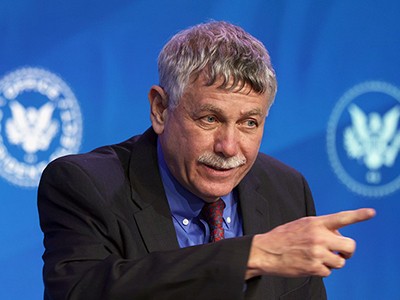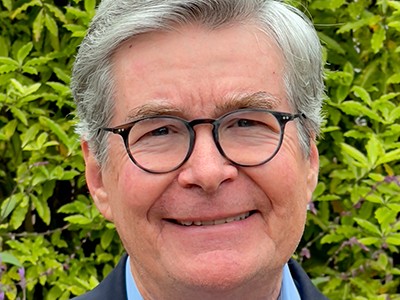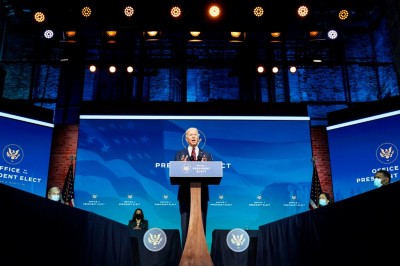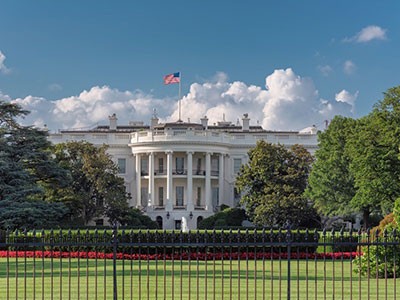
Eric Lander soon after being nominated to be US science adviser in January 2021.Credit: Matt Slocum/AP/Shutterstock
When US President Joe Biden tapped the now-disgraced Eric Lander to be his science adviser, the grass-roots organization 500 Women Scientists wrote in Scientific American that “his nomination does not fill us with hope that he will shepherd the kind of transformation in science we need if we are to ensure science delivers equity and justice for all”.
This and other warnings turned out to be prescient. Last week, Lander, whose position includes the role of director of the Office of Science and Technology Policy (OSTP), was forced out after it became public that an internal investigation had found that he had bullied and demeaned staff.
When a cabinet member heads for the exit because of wrongdoing, the person at the top will almost invariably utter the immortal words ‘lessons will be learnt’ before swiftly moving to appoint or announce a successor or, at the very least, an acting leader.
Researchers frustrated as Biden’s science adviser resigns amid scandal
Alongside considering successors to Lander, the Biden administration has some explaining to do. A number of major questions urgently need answering: why and how was bullying tolerated, especially considering the president’s assertion in early 2021 that he would fire anyone caught treating people with disrespect on the spot? Should this not have happened in Lander’s case, once the investigation into his behaviour was complete and the findings became known to the White House?
The administration also needs to explain why the existence of the investigation was not made public. Lander was allowed to stay on to try to resolve his behaviour — until the magazine Politico revealed that there had been an investigation and made its findings public. Does that mean we would never have known without the media’s reporting?
Another urgent question is whether whistle-blowers are being properly supported. It takes courage to come forwards and report misbehaviour at the top of an organization; when the person misbehaving is the head of an office in the White House, and reports to the president of the United States, it takes monumental courage.
Biden needs scientists with policy chops
Appointments to the government should require hefty due diligence. Was something remiss with that process? Lander was questioned about previous controversies during Senate confirmation hearings in April. For example, he had to apologize for understating the contributions of Jennifer Doudna and Emmanuelle Charpentier, who both helped to pioneer CRISPR gene-editing technology, in an essay published in Cell called ‘The Heroes of CRISPR’ (E. S. Lander Cell 164, 18–28; 2016). Nevertheless, many in the scientific community — including Nature — still applauded Biden’s choice and urged his team to pull together.
Finally, there is a question that needs to be asked about the role itself. Does a scientific advisory structure that is built around one individual’s leadership and their access to the president prevent the director from being held to the same standards expected of all other OSTP staff?
Researchers who study science and government are searching for answers to some of these questions. The White House should tap into their expertise.
Channelling science
The United States, China, the European Union and Japan are among the world’s largest spenders on science and technology, and there are many similarities between their respective science systems. But there are notable differences, too. The United States, for example, has no government ministry or department for science — instead, responsibility for different science-focused agencies is shared between the government’s executive and legislative branches. The OSTP is also unusual; most nations do not have an equivalent office.
The OSTP exists, in part, to channel the scientific community’s opinions to the nation’s leadership. It also helps to identify future funding priorities; promotes a president’s own science agenda; and helps the government with the process of setting budgets for different science agencies.
Biden has assembled a stellar science team — now they must pull together
Another unusual feature of the United States’s system is that the president’s science adviser and OSTP head leaves their post when the party in government changes. In many other countries that have a comparable office — such as India, New Zealand and the United Kingdom — the adviser does not immediately leave their job when there is a change of government. In New Zealand, the scientific adviser’s terms of reference include being able to brief the leader of the opposition party. Sometimes, a nation’s chief science adviser is one of a larger group of scientific advisers attached to different government ministries, such as defence or foreign affairs.
There are pros and cons to each approach. A long-standing attraction of the US system is that the scientific community has an advocate for science and evidence reporting to the White House. But the system invests a considerable degree of influence and responsibility in one person.
All of this suggests that there are good reasons for researchers who study science systems to evaluate how the United States organizes its scientific advice to the president, and to ask whether other models should be considered. For example, should the OSTP continue to be led by one person, or is a shared leadership model more desirable? Would such a model even be possible? Would it be appropriate, or feasible, for the scientific adviser to stay in position when administrations change? Could that help to ensure at least some continuity in advisory structures, and in policies, when there is a change of government? And what are the benefits of having a scientific adviser who is able to continue in office when a new party takes over?
Conversely, what are the potential risks and downsides to changing a system that has long been envied around the world? Finding answers to these questions will not be straightforward, but asking the questions could open up different routes to positive change.
The cabinet question
Researchers point out that the structure of the US president’s scientific advisory system is unusual in one other respect. Last year, Biden placed Eric Lander in his cabinet. In the absence of a department for science, this enables the scientific adviser to be directly involved in government decisions that need scientific input or that affect science. The move was hailed by many as a welcome step. After the damage wreaked by the Trump administration, it would lead to closer connections between the White House, the scientific community and the executive branch of government. But it also presented a challenge.
Many science-policy researchers say that an adviser should advise, propose or comment on policy choices on the basis of a thorough evaluation of the available evidence by members of the scientific community. But, on the whole, they should leave implementing policy to others, such as science funding agencies or the departments headed by cabinet ministers (or secretaries, as they are usually called in the United States). This is why it is unusual for a science adviser to sit in the cabinet, the role of which is to oversee the implementation of the government’s decisions.
The United States needs a department of technology and science policy
In November, however, two former chiefs of the National Institutes of Health, Harold Varmus and Elias Zerhouni, proposed the creation of a cabinet-level Department of Technology and Science Policy (H. Varmus and E. Zerhouni Nature 600, 30–32; 2021). Among other things, this department would represent science in the cabinet and would take responsibility for some policy implementation that currently rests with OSTP, including the creation of an Advanced Research Projects Agency for Health or a plan to create a new pandemic-preparedness agency.
Researchers in the fields of economics and innovation, political science, sociology, and science and technology studies have analysed governance structures and systems extensively, and have given much thought to the benefits and risks of different ways of organizing how science advice gets to governments. These studies are intended to help to reduce conflicts of interest, to ensure that the machinery of government continues to function when there are problems, and, increasingly, to look for creative ways to support equity and inclusion. The separation of powers between the executive, legislature and judiciary is a core principle in democratic governance. Researchers need to ask whether this principle should apply to science policy, too.
Awaiting answers
With the polarizing debates over subjects from climate change to COVID-19 vaccines and lockdowns, science in the United States is experiencing one of its most politicized periods. At the same time, the pandemic has raised the need for, and the public profile of, scientific advisers to new heights.
Lander’s resignation is the Biden administration’s first cabinet-level fall. The White House needs to take great care in what it does next. There is undoubtedly pressure to appoint Lander’s successor swiftly — names are already being suggested to ensure continuity and steady the ship.
But important questions remain to be answered. The White House must address questions about Lander’s behaviour and the nature of the OSTP environment, in which his bullying was allowed to happen, and must explain how it is supporting those who bravely came forwards. Meanwhile, researchers should investigate broader concerns, including questions about the structure of the system. Once the administration starts to address the questions that we and others are raising, it will discover that there could be much to gain from changing more than just the person at the top.

 Biden needs scientists with policy chops
Biden needs scientists with policy chops
 Researchers frustrated as Biden’s science adviser resigns amid scandal
Researchers frustrated as Biden’s science adviser resigns amid scandal
 The United States needs a department of technology and science policy
The United States needs a department of technology and science policy
 First science adviser in US president’s cabinet talks COVID, spying and more
First science adviser in US president’s cabinet talks COVID, spying and more
 Biden has assembled a stellar science team — now they must pull together
Biden has assembled a stellar science team — now they must pull together
 ‘Inspired choice’: Biden appoints sociologist Alondra Nelson to top science post
‘Inspired choice’: Biden appoints sociologist Alondra Nelson to top science post
 Why Nature needs to cover politics now more than ever
Why Nature needs to cover politics now more than ever





